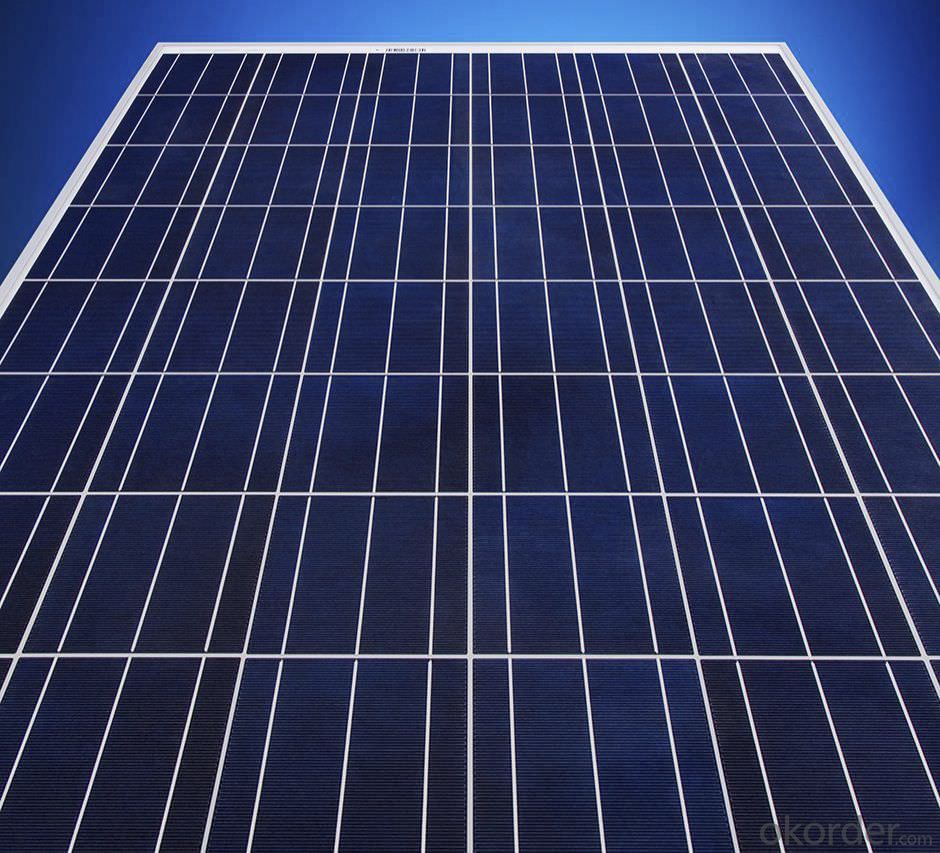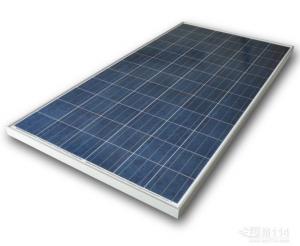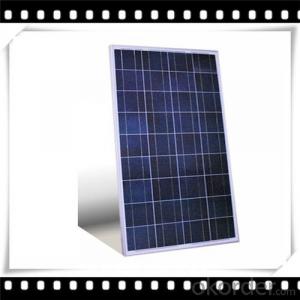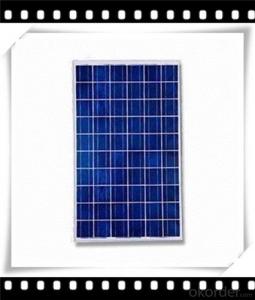20W Polycrystalline Solar Panel Mini Poly Solar Panel Lewes CNBM
- Loading Port:
- Qingdao
- Payment Terms:
- TT OR LC
- Min Order Qty:
- 10 set
- Supply Capability:
- 300000 set/month
OKorder Service Pledge
OKorder Financial Service
You Might Also Like
Polycrystalline Solar Modules
CNBM offers a range of small, medium and large polycrystalline solar modules, designed for a range of requirements.


Specifications:
Tolerance | +/-3% |
Cell | Polycrystalline silicon solar cells (156 x 156mm) |
N0. of Cells | 60 (0 x 6) |
Dimension of Modules (mm) | 1650 x 990 x 40 |
Weight (kg) | 25.5 |
Limits:
Operating Temperature | -40~+85? |
Storage Temperature | -40~+85? |
Maximum System Voltage | 1000 VDC max. |
Hail Impact | Diameter of 28mm with impact speed |
Temperature and Coefficients:
NOCT | 48C+/-2? |
Voltage temperature coefficient (%/K) | -0.35 |
Current temperature coefficient (%/K) | 0.05 |
Power temperature coefficient (%/K) | -0.45 |
Characteristics:
Model: | SGM-200P | SGM-210P | SGM-220P |
Max-power voltage Vmp (V) | 29.2 | 29.4 | 29.41 |
Max-power current Imp (A) | 6.85 | 7.14 | 7.48 |
Open-circuit voltage Voc (V) | 36.5 | 36.69 | 36.9 |
Short-Circuit Current Isc (A) | 7.28 | 7.6 | 7.93 |
Max-power Pm(W) | 200 | 210 | 220 |
Model: | SGM-230P |
Max-power voltage Vmp (V) | 29.8 |
Max-power current Imp (A) | 7.72 |
Open-circuit voltage Voc (V) | 37.31 |
Short-Circuit Current Isc (A) | 8.19 |
Max-power Pm(W) | 230 |
STC: Irradiance 1000W/m2, module temperature 25?, AM-=1.5
Poly Crystalline Solar Panels Specifications Range
Maximum Power (Pm) | Dimension | Weight | Operating Voltage (Vmp) | Operating Current (Imp) | Open Circuit Voltage (Voc) | Short Circuit Current (Isc) |
0.45W | 140x80x10mm | 0.08kg | 3.3V | 150mA | 4.6V | 160mA |
1.0W | 162x140x10mm | 0.16kg | 7.5V | 150mA | 10.3V | 160mA |
4.5W | 269x251x23mm | 0.8kg | 16.5V | 0.27A | 20.5V | 0.3A |
10W | 420.1×268.9×22.6mm | 1.92kg | 17.5V | 0.58A | 20.5V | 0.6A |
20W | 425x502x50mm | 3.0kg | 16.8V | 1.19A | 21.0V | 1.29A |
30W | 593x502x22.6mm | 3.9kg | 16.8V | 1.78A | 21.0V | 1.94A |
40W | 655x537x50mm | 5.75kg | 17.3V | 2.31A | 22.1V | 2.54A |
50W | 839x537x50mm | 6.0kg | 17.5V | 2.9A | 21.8V | 3.17A |
65W | 1111x502x50mm | 7.2kg | 17.6V | 3.69A | 22.1V | 3.99A |
80W | 1204x537x50mm | 7.7kg | 17.6V | 4.55A | 22.1V | 4.8A |
- Q: Can solar panels be used to power a hotel?
- Yes, solar panels can be used to power a hotel. By installing a sufficient number of solar panels, a hotel can generate a significant amount of electricity to meet its power needs. This not only helps to reduce energy costs but also promotes sustainability and environmental responsibility.
- Q: Can solar panels be installed on a pergola or shade structure?
- Yes, solar panels can be installed on a pergola or shade structure. However, it is important to ensure that the structure is sturdy enough to support the weight of the panels and that they are properly angled to receive maximum sunlight. Additionally, the design and installation should be done by professionals to ensure safety and optimal performance.
- Q: Can solar panels be used for powering water treatment plants?
- Yes, solar panels can be used for powering water treatment plants. Solar energy can be harnessed through photovoltaic panels to generate electricity, which can then be used to power the various processes involved in water treatment plants. This renewable energy source offers a sustainable and environmentally-friendly solution for powering water treatment facilities.
- Q: Can solar panels be installed in areas with high pollution levels?
- Yes, solar panels can be installed in areas with high pollution levels. While pollution can potentially reduce the efficiency of solar panels, they can still generate electricity even in polluted areas. Regular cleaning and maintenance of the panels can help mitigate the impact of pollution and ensure optimal performance. Additionally, installing solar panels can contribute to reducing pollution by promoting the use of clean and renewable energy sources.
- Q: I am designing a solar panel but i need to have maximum power output.How can i optimize the equation for power Total power=voltage * current to get maximum power.
- first place the panel so it is at right angles to the solar rays. Make sure none of the panel has any shade whatsoever. For best results use motor drives to keep it in that position as the sun moves across the sky. For overall maximum versus time, you need to be near the equator. Solar cells have a high internal resistance, so for maximum power transfer, you need a load of that same resistance. A good charge controller will use DC-DC converters to provide that load. .
- Q: I'm doing a project for school where I will buy a solar panel and utilize/improve the power output of the panel. I want the panel to have an improved amount of energy output compared to the original. My budget for the solar panel itself is ~$00. Anything else that will be needed is covered.Also, I will be comparing the power by lighting a light bulb and checking to see the output energy of the panel.Where or how should I approach this project?What are the parts of the solar panel that I will need to buy?What factors could I change/improve to improve the overall energy output?What are the things (other than the panel) that I will need to buy?How can I attach a light bulb to the solar panel?
- Solar okorder /
- Q: There are so many solar panels and kits it is very confusing. I need to know what exactly I would need if I had an underground home with no electricity. I want to be totally off the grid with solar power. Someone please explain to me in simple terms what exactly I need. Maybe give me a link to the right kit for me. Also are they easy to install? Are there instructions that I need to download?Thank you
- I okorder
- Q: Looking to install solar panels in my house.
- Wholesale prices for BP solar panels range between $335 for the 40 watts panel to $835 for the 70 watts panel. Here's a brief listing of wholesale prices for BP solar models: - BP340J solar panel (40 watts) @ $335 - BP350J solar panel (50 watts) @ $37 - BP375J solar panel (80 watts) @ $504 Right now I'm getting a series of 50 watt (7.5 volts) panels installed in my house. It's a start to reduce dependence on electricity bills and try get some tax rebates as well.
- Q: Is this true in a dc system? What if my battery current is negative?
- I am not sure about your question ? If your Q is, what is the solar panels current output, it is 8.73A regardless of the load. If the Q is, How much extra current is available in this circuit, the answer is 3.58A ( 8.73 - 4.32-.83= 3.58)
- Q: Hello,What do you all think about the future of solar panels and what role they will play in the near future. There is tons of money being dumped into the industry and demand is slowly rising. Also do you have any favorite solar links to get more info about them?
- Well, it's true that solar panels aren't exactly the new invention. However, solar technologies keep improving all the time. Just like computers used to be super rare and hard to get, but right now almost everyone has a PC or a laptop. Same with solar panels, soon they will get a lot more popular. Even people like Bill Gates are interested in solar solutions, here, take a look:
Send your message to us
20W Polycrystalline Solar Panel Mini Poly Solar Panel Lewes CNBM
- Loading Port:
- Qingdao
- Payment Terms:
- TT OR LC
- Min Order Qty:
- 10 set
- Supply Capability:
- 300000 set/month
OKorder Service Pledge
OKorder Financial Service
Similar products
Hot products
Hot Searches
Related keywords


























